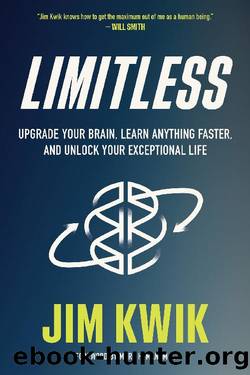Limitless ,, Upgrade Your Brain, Learn Anything Faster, and Unlock Your Exceptional Life by Jim Kwik

Author:Jim Kwik
Language: eng
Format: mobi
Publisher: Hay House
Published: 2020-03-18T00:00:00+00:00
This, of course, is essential to how we conduct our lives. Could you imagine how overwhelming it would be if you had to think about every single thing you did? If even brushing your teeth required some conscious level of calculation, you’d be exhausted by 10 in the morning.
“Without habit loops, our brains would shut down, overwhelmed by the minutiae of daily life,” writes Charles Duhigg in his best-selling book, The Power of Habit. “People whose basal ganglia are damaged by injury or disease often become mentally paralyzed. They have trouble performing basic activities, such as opening a door or deciding what to eat. They lose the ability to ignore insignificant details—one study, for example, found that patients with basal ganglia injuries couldn’t recognize facial expressions, including fear and disgust, because they were perpetually uncertain about which part of the face to focus on.”5
James Clear, author of the best-selling book Atomic Habits, says, “The habits you repeat (or don’t repeat) every day largely determine your health, wealth, and happiness. Knowing how to change your habits means knowing how to confidently own and manage your days, focus on the behaviors that have the highest impact, and reverse-engineer the life you want.”6
“All habits serve you in some way,” Clear told me. “As you go through life, you face a variety of problems. You need to tie your shoe; your brain is automating the solution to that problem. That’s what a habit is. It’s the solution to a recurring problem that you face throughout life, one that you’ve employed so many times that you can do it without thinking. If the solution doesn’t work anymore, then your brain will update it.”7
Clear identifies the habit loop as having four components: a cue, a craving, a response, and a reward. Using the example of turning on a light when you enter a room, the cue is walking into the room and finding it dark. The craving is feeling that there would be some value in the room not being dark. The response is flipping on the light switch, and the reward is that the room is no longer dark.8 You can apply this loop to any of your habits, such as getting your mail when you come home from work. The cue is reaching your driveway or front door at the end of the day. The craving is hoping there’s something in the mailbox. The response is going to the mailbox to find out. And the reward is getting the mail out of your mailbox. You probably didn’t think about any of this until you actually had the mail in your hands.
Download
This site does not store any files on its server. We only index and link to content provided by other sites. Please contact the content providers to delete copyright contents if any and email us, we'll remove relevant links or contents immediately.
| ASVAB | GED |
| GRE | NCLEX |
| PRAXIS | SAT |
| See more | Flash Cards |
| Study Guides | Study Skills |
| Workbooks |
Talking to Strangers by Malcolm Gladwell(13194)
The Compound Effect by Darren Hardy(8789)
Tools of Titans by Timothy Ferriss(8187)
Wonder by R. J. Palacio(7974)
The Lover by Duras Marguerite(7806)
A Court of Wings and Ruin by Sarah J. Maas(7622)
The Circle by Dave Eggers(7021)
Deep Work by Cal Newport(6856)
Kaplan MCAT General Chemistry Review by Kaplan(6851)
To All the Boys I've Loved Before by Jenny Han(5759)
Wiseguy by Nicholas Pileggi(5650)
The Body: A Guide for Occupants by Bill Bryson(4954)
1,001 ASVAB Practice Questions For Dummies by Powers Rod(4437)
Eat That Frog! by Brian Tracy(4411)
Cracking the GRE Premium Edition with 6 Practice Tests, 2015 (Graduate School Test Preparation) by Princeton Review(4204)
Pre-Suasion: A Revolutionary Way to Influence and Persuade by Robert Cialdini(4119)
Barron's AP Biology by Goldberg M.S. Deborah T(4082)
ACT Math For Dummies by Zegarelli Mark(3972)
Alive: The Story of the Andes Survivors by Piers Paul Read(3955)
